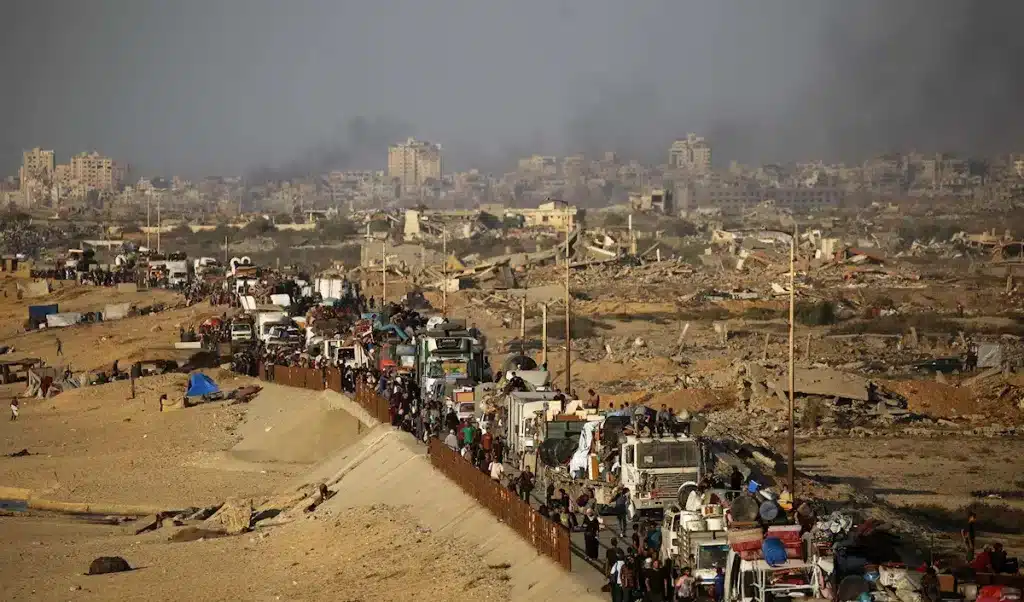
Hundreds of thousands of Palestinians have fled Gaza City since late August. Photo: Eyad Baba/AFP.

Orinoco Tribune – News and opinion pieces about Venezuela and beyond
From Venezuela and made by Venezuelan Chavistas

Hundreds of thousands of Palestinians have fled Gaza City since late August. Photo: Eyad Baba/AFP.
By Youssef Fares – Sep 24, 2025
Gaza | The Israeli incursion into Gaza City’s central neighbourhoods has advanced in just three days at a pace that would normally take months. Netanyahu appears intent to announce full control over the City on the upcoming October 7 anniversary, and the tanks are moving on his timetable. This offensive is accompanied by the fiercest bombardment the city has seen since the start of the war.
The Israeli army is mounting its ground offensive along three axes. The first advances from the northeast through Abu Iskandar, Al-Nafaq, and Jabalia al-Balad neighbourhoods toward Salah al-Din Street. The second comes from the northwest, where tanks have moved in from the Zikim outpost into Karamah and al-Nasr neighborhoods and up to the edges of Al-Shatii Camp and the northern beach. The third opened recently from the south, cuts through Street 8 into Tel al-Hawa. Over the last three days, Israeli armour has reached the area near the universities’ square in central Gaza.
In its campaign to drive people out, the Israeli army is employing a repertoire of criminal tactics, including:
• Use of vehicle-borne improvised explosive devices to blow up residential neighbourhoods without warning.
• Concentrated fire on densely populated districts by threatening multiple residential blocks simultaneously, without identifying specific targets, forcing hundreds of thousands to leave their homes and sleep in the streets for days, stripping them of any sense of security.
• Deliberate destruction of residential towers and multi-storey buildings. Each strike instantly deprives hundreds of families of homes and repeated strikes erode civilians’ incentive to remain by removing the very basis of life in the city.
• Imposing strict control through “quadcopter” drones and snipers have turned whole neighbourhoods into ghost towns, where residents even fear leaving their houses to fetch water.
• Deliberate strikes on tent camps packed with thousands of displaced people in north-west Gaza and at Gaza Port (attacks that have recurred in recent days).
• Targeting the arteries of life and the essentials of survival, most notably water and health services. Israel struck central water wells and pipelines that supply densely inhabited neighbourhoods, particularly al-Nasr, al-Shifa and Al-Shatii Camp, forcing residents to search for those resources elsewhere. It also evacuated the Jordanian field hospital in Tel al-Hawa and the facilities of the Medical Relief NGO.
• Spreading terror by committing large-scale massacres against families who choose to stay. Israel struck the Daghmash family in Tel al-Hawa- one of the families that had remained since the start of the war- and the Zaqqout family in Karamah, killing about 80 members in a single strike. The occupier presents such massacres as a warning to terrify those still in the city.
• Sending texts and voice messages to residents, dropping evacuation leaflets, and mobilizing dozens of Israeli media outlets in the intimidation campaign by broadcasting statements from military commanders boasting about the forced displacement and threatening to wipe out the city.
Israeli estimates say roughly 500,000 people have fled Gaza City since the start of the ground operation, while a similar number refuse to leave. Yet the pace of bombardment and ongoing destruction is steadily driving more displacement. Targeting health institutions, particularly al-Shifa Hospital, which is less than a kilometer from Israeli tanks, will deprive those who remain of any means of endurance and survival.
So far, the resistance has not launched full-scale operations. Past experience suggests these begin after the preparatory bombardment and the use of explosives subside—that is, when Israeli soldiers relax and security protocols loose. At the same time, diplomatic mediation efforts to revive negotiations are colliding with an intransigent Israeli side who appears determined to kill off any chance of a prisoner exchange deal.
Support Groundbreaking Anti-Imperialist Journalism: Stand with Orinoco Tribune!
For 7 years, we’ve delivered unwavering truth from the Global South frontline – no corporate filters, no hidden agenda.
Last year’s impact:
• More than 200K active users demanding bold perspectives
• 216 original pieces published in 2025 alone
Fuel our truth-telling: Every contribution strengthens independent media that actually challenges imperialism.
Be the difference: DONATE now to keep radical journalism alive!